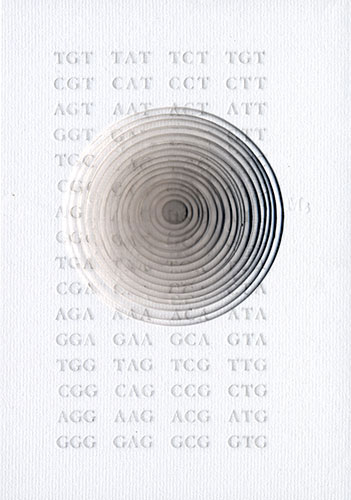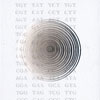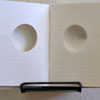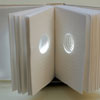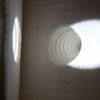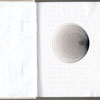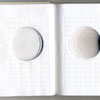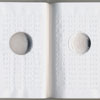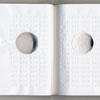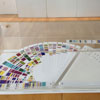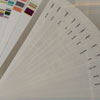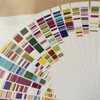Technology And The Evolution Of The Artist’s Book
Curated by Maddy Rosenberg
Catalog (pdf)
Press:
http://www.phoenixbrighton.org/press-release-technology-and-the-evolution-of-the-artists-book/
http://www.phoenixbrighton.org/events/press-release-2016/
http://www.phoenixbrighton.org/press-release-2016-resources/
Works in The Exhibition
M168 Books 2007
16 books
Letter pressed
Dye cut with a circle
Papers, Arches Cover, Vellum, Rice Paper, Fabriano
Hand Bound in White Linen
4 With the Entire Genetic code
4 With the Y Chromosome M3-M168
4 With the Y Chromosome M168-M3
4 Blank
Each book 3” x 5”
All 16 3” x 5” books in this exhibition are unique hand bound letterpress embossed works based on Y chromosome genetic markers. One set of four books is letterpress embossed with the “Table of Standard Genetic Code”. The second set of four has the “Standard Code “ with the anomalies that identify each racial group. Both sets have a funneling hole cut into the center, taking out the core of information. The chromosomal marker number is letterpress printed at the right side of the whole, beginning with M3, representing Native Americans, and ending with M168, representing the Bush people. These books trace the markers on the Y chromosomes from the last migration of first peoples 10,000 year ago to the origins of humans 40,000 years ago.
The third set of books has a funneling hole in the center with the chromosomal numbers letterpress printed at the bottom center, as if they were page numbers. This set begins with M168, the Bush people, and ends with M3, Native Americans, in the center. These books trace the actual migration from 40,000 to 10,000 years ago. The fourth set of books are cut in the same circular form but are left blank. The books line the wall of the gallery space so that the viewer can look at each unique piece. Each book in a set is made with a different type of paper (full list of Y Chromosome marker below).
Chromosome Painting Book 2013
Laser and Letterpress printed on photo rag paper
Closed 2” x 20”, Open 40” fan
Chromosome Paintings Book is based on the image of a synteny map, a colorful, striped array that compares gene sequences and chromosomes across [among] species. The technique of chromosome painting, also known as “fluorescence in situ hybridization,” can detect chromosomal abnormalities like translocations and structural alterations associated with various diseases. For example, chromosome 19 carries a gene implicated in leukemia. With these disease associations in mind, each page is letterpress printed with the type of cancer correlated with a genetic marker present on the chromosome. The book is based on a pantone color sample book commonly used by artists.
Preface-curator Maddy Rosenberg
Conceived and developed by Phoenix Brighton, this is the third in a series of unique exhibitions and events focusing the on the presentation of artists’ books within a unique, hands-on setting. This year, we present a selection of boundary-breaking bookworks within a stunning installation designed by Phoenix Brighton based designers called Curious Space. The exhibition features the work of notable contemporary artists from across the world who approach the book as an art form. For some of these artists, the material and sensory nature of the book is primary; for others, the image and the text carry equal weight. The work in this exhibition embodies a fresh, experimental, and daring approach to the wide-ranging field of artists’ books, and also reveals the surprising and imaginative ways in which artists utilize technologies, old and new, in the process of realizing their vision. Selected by Maddy Rosenberg, the director of New York’s CENTRAL BOOKING art space, the bookworks have been brought together within a theatrical display designed by scenographers Anna Jones and Patrick Burnier / Curious Space and constructed by sculptor Ben Thomson. Visitors will experience a dramatic re-invention of the gallery as a place in which they can encounter the artist’s book in a direct and imaginative way.
Exhibitors include Book Art Museum (Lodz, Poland), Erik Demaine and Martin Demaine, Tina Flau, Art Hazelwood, Eagle Gallery / EMH Arts, Valerie Huhn, Kahn + Selesnick, Eunkang Koh, Liberature (Katarzyna Bazarnik and Zenon Fajfer), Despo Magoni, Max Marek, Heidi Neilson, Geraldine Ondrizek, Marianne R. Petit, Maddy Rosenberg, Susan Rostow, Buzz Spector, Sarah Stengle and Mary Ting.
Curator’s Statement
If we return to the early days of humans, arguably the first books, visual passages of communication, are image-based text. The cave paintings are an overlay narrative of life over centuries; the temples of Egypt are slabs of chiseled stone in image with text, text as image; Chinese scrolls unroll with brush line and value, building landscapes of a story; a Mayan codex is a folded, accordion, unbound paper book. The image and the text, combined with structure, have always been integral to the book, unknowing collaborations among artists, artisans, and scribes. The invention of the printing press, a simple mechanical technology allowing us to disseminate information more quickly to a mass audience with the advent of public education, may have become a tool in the development in the spreading of knowledge. However, we slowly began to forget about the artistry of the book and reduced it to a mere bound container of written information, occasionally “illustrated.” In the West, the line lost its visual magic, and it became just a letter to spell a word.
But to the artist, ever experimenting with the visual and textual meaning, the separation never quite processed. Others may not have looked upon their work as a book because the form was not yet recognized as such, but the work was meant to be read in the most basic meaning of the word. This is an exhibition of contemporary artists who work with the book as an art form, whether it be the word in search of the visual or the visual seeking the word or a balancing act between the two. These international artists incorporate old and new technology, materials that may or may not include paper, and for that matter, may or may not include printing, sometimes searching back in history for technologies even simpler than the printing press.
Maddy Rosenberg is an artist, curator, and director of CENTRAL BOOKING in New York, a multi-disciplinary art space focusing on artists’ books and their integration into the larger art world through exhibitions on art and science. centralbookingnyc.com
Curious Space (Anna Jones and Patrick Burnier) is a design studio based at Phoenix Brighton. It creates unique and inspiring spaces for museums, galleries, public spaces, and performance. Curiousspace.com
M168 Books
Set I: M168 Books I– IV
4 books letterpress-embossed in Garamond 10-point type with the Standard Genetic Code, TCAG 3 x 5 in. each paper: I. vellum, II. Hoshu, III. Arches Cover, IV. rice paper die-cut with consecutive circles ranging from 2 in. to 1/8 in.
Chapters:
Each book is divided into 13 chapters tracing the markers on the Y chromosome from the last migration of Native Americans 10,000 years ago (M3) to the origins of humans 50,000 years ago in Africa (M168).
M3 Americas 10,000 years ago
M242 Siberia 10,000 years ago
M173 Northern Europe 30,000 years ago
M17 Indo-European and Steppes 10,000 years ago
M172 Mediterranean 10,000 years ago
M122 East Asia 10,000 years ago
M45 Central Asia 35,000 years ago
M175 Southeast Asia 35,000 years ago
M20 India 30,000 years ago
M9 Eurasian 40,000 years ago
M89 Central Middle East 45,000 years ago
M130 Australia 50,000 years ago
M168 Africa 50,000 years ago
Set II: Anomalies, M168 Books I–IV
4 books letterpress-embossed in Garamond 10-point with the Standard Genetic Code including genetic anomalies connoting different races
3 x 5 in. each
paper: I. vellum, II. Hoshu, III. Arches Cover, IV. rice paper
die-cut with consecutive circles ranging from 2 in. to 1/8 in.
Chapters:
Each book is divided into 13 chapters tracing the markers on the Y chromosome from the last migration of Native Americans 10,000 years ago (M3) to the origins of humans 50,000 years ago in Africa (M168).
M3 Americas 10,000 years ago
M242 Siberia 10,000 years ago
M173 Northern Europe 30,000 years ago
M17 Indo-European and Steppes 10,000 years ago
M172 Mediterranean 10,000 years ago
M122 East Asia 10,000 years ago
M45 Central Asia 35,000 years ago
M175 Southeast Asia 35,000 years ago
M20 India 30,000 years ago
M9 Eurasian 40,000 years ago
M89 Central Middle East 45,000 years ago
M130 Australia 50,000 years ago
M168 Africa 50,000 years ago
Set III: M3 Books I–IV
4 books letterpress-embossed in Garamond 10-point type
3 x 5 in. each
paper: I. vellum, II. Hoshu, III. Arches Cover, IV. rice paper
die-cut with consecutive circles ranging from 2 in. to 1/8 in.
Chapters:
Each book is divided into 13 chapters tracing the migratory patterns of humans, from Africa 50,000 years ago (M168) to the Americas 10,000 years ago (M3), as indicated on the Y chromosome.
M168 Africa 50,000 years ago
M130 Australia 50,000 years ago
M89 Central Middle East 45,000 years ago
M9 Eurasian 40,000 years ago
M175 Southeast Asia 35,000 years ago
M45 Central Asia 35,000 years ago
M173 Northern Europe 30,000 years ago
M20 India 30,000 years ago
M122 East Asia 10,000 years ago
M172 Mediterranean 10,000 years ago
M17 Indo-European and Steppes 10,000 years ago
M242 Siberia 10,000 years ago
M3 Americas 10,000 years ago
Set IV: Books I–IV
4 blank books
3 x 5 in. each
paper: I. vellum, II. Hoshu, III. Arches Cover, IV. rice paper
die-cut with consecutive circles ranging from 2 in. to 1/8 in.
